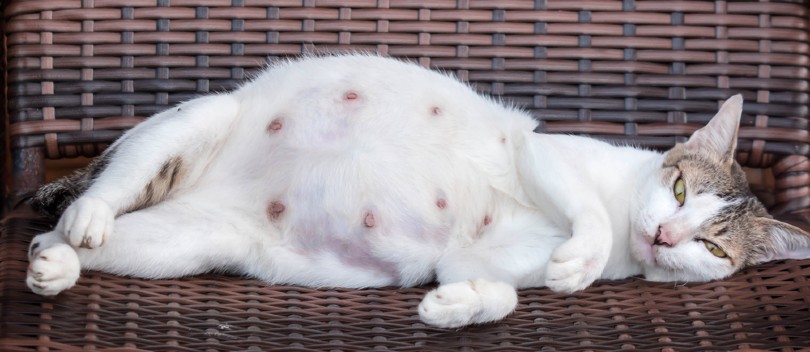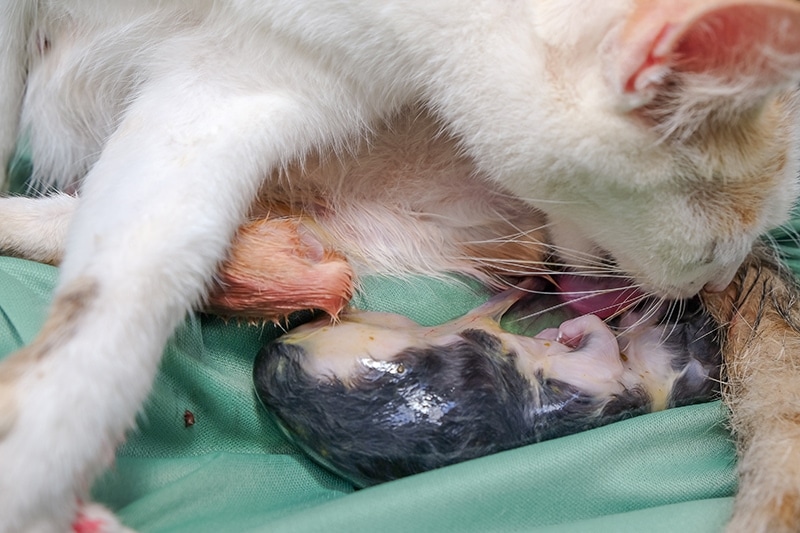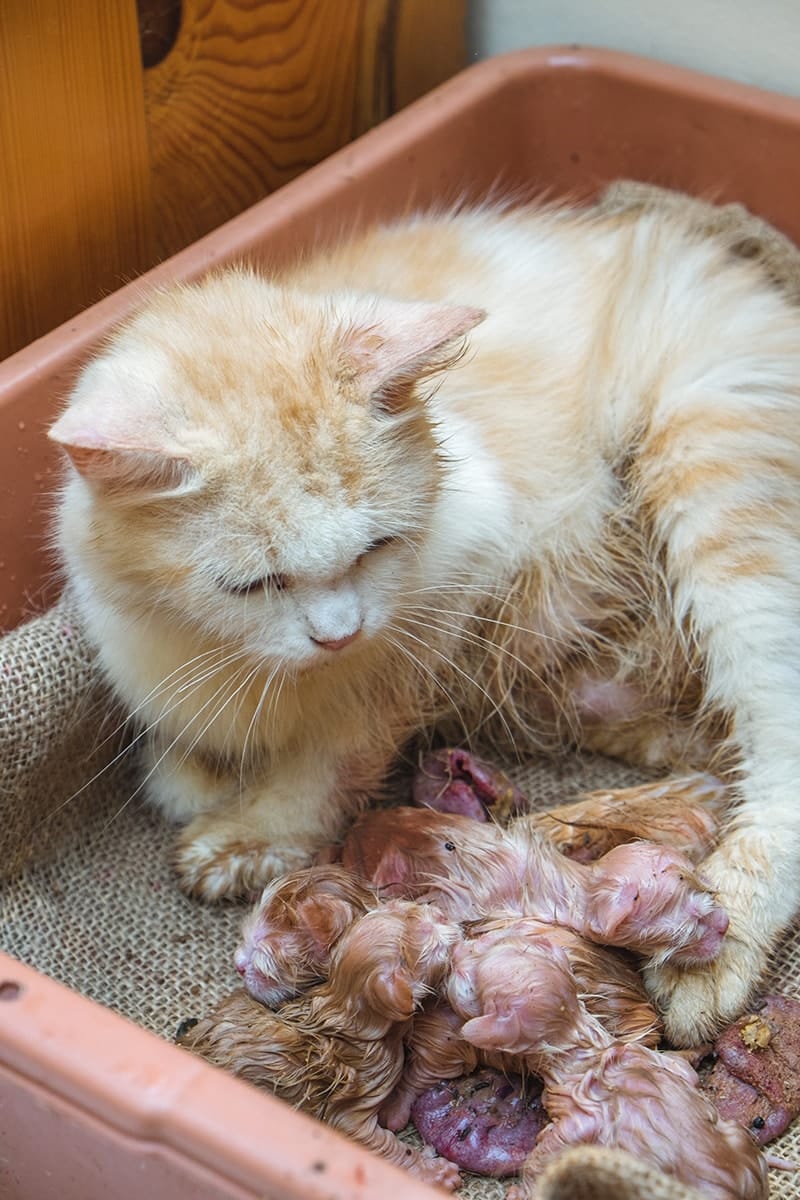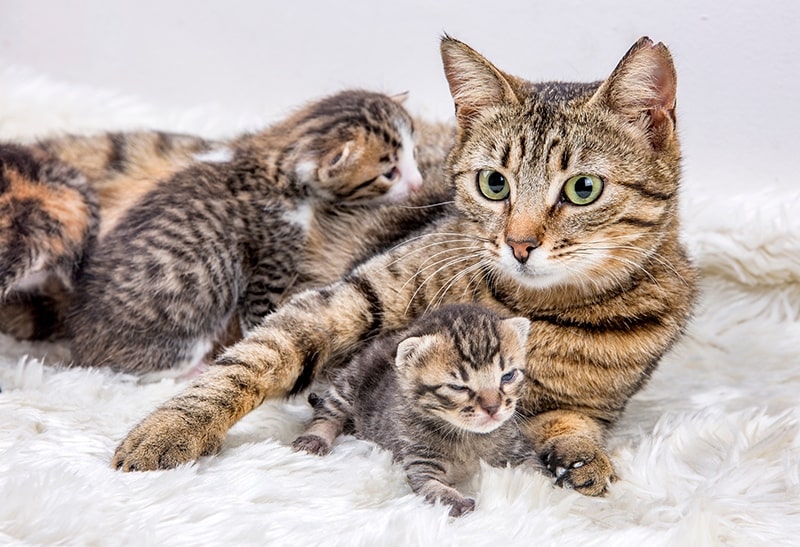The amount of time a cat is in labor varies, and kittens can be born between minutes to about an hour apart. Sometimes, mother cats can go into interrupted labor and stop straining between 24 to 36 hours before they commence giving birth again. So, it’s very possible for a cat to give birth to her entire litter in the span of a few days.
While the time between births can indicate the difficulty of the labor, other factors can determine how your cat is doing and if professional veterinary intervention is necessary.
The 3 Stages of Labor in Cats
1. The cat’s body makes preparations to go into labor
Cats go through three stages of labor1. In the first stage, the cervix relaxes and dilates, and kittens can sometimes be seen moving through the abdominal wall. Cats will also start to experience contractions, but they’ll be small and hardly noticeable.
In the first stage, cats may pant and want reassurance from owners if they’ve formed a bond. This stage can last up to about 36 hours.

2. More frequent contractions and birth
During the second stage, cats experience more frequent contractions and start to give birth to kittens. Each kitten can take 5 to 30 minutes to be delivered.
3. The afterbirth
The third stage usually immediately follows the delivery of a kitten and is the passage of fetal membranes and the placenta. This stage is also known as the afterbirth. Sometimes, the next kitten can be birthed right after the previous one, and the fetal membranes will follow the second kitten’s birth.

 Cats and Interrupted Labor
Cats and Interrupted Labor
The period between births can last just a few minutes to an hour. In some instances, mother cats will have interrupted labor. Cats can halt giving birth for a limited amount of time. It’s unclear which cats will have interrupted labor, but it can happen if they have developed a dependency on their owner and don’t want to give birth without their owner present.
It’s fairly common for cats to have interrupted labor, and it doesn’t mean that a cat’s in trouble. However, it’s best for owners to be near their cats during labor to help with a smooth delivery. Also, they can contact a vet with any questions since birthing times longer than an hour between kittens can indicate problems that might require immediate veterinary attention.
Cats can produce four to six kittens per litter; in uncommon instances, labor can take more than a day. For the sake of safety, owners should prepare for the labor and deliveries to last a long time.

Signs of a Difficult Labor for Cats
Cats going into labor can raise anxious or nervous feelings, especially for people experiencing it for the first time. Knowing the difference between healthy and risky labor can help you feel prepared and ensure the litter is delivered safely.
Difficulty in any stage of labor is referred to as dystocia.
- More than 30 minutes of strong contractions without delivering a kitten
- The first stage lasts for more than 4 hours before the first kitten is born
- More than 1 to 2 hours between delivery of offspring (except for interrupted labor)
- Rectal temperature dropping below 99°F
- Mother cat crying in pain and repeatedly licking the vulvar area
- Bloody discharge before the delivery of the first kitten
Labor complications can happen for several reasons. Sometimes, the fetus is oversized, stillborn, or in an abnormal position. The mother’s physical condition can also affect the delivery. Factors like infections, uterine complications, insufficient cervical dilation, and malnutrition can all play a role in complicating labor. Cats with a previous history of dystocia are also at risk of repeated occurrences.
Regularly communicating with your veterinarian and keeping up with veterinary appointments can ensure your cat experiences a smooth delivery. Contact your veterinarian or your nearest animal emergency care if you’re ever in doubt. Most cases of dystocia require veterinary intervention to keep the mother and kittens safe.
Conclusion
Cats can experience interrupted labor, which can cause the delivery process to last a couple of days. Monitoring your cat’s behavior and looking for unusual signs during labor can ensure they give birth in a safe environment and have all the help they need.
If you’re ever in doubt, don’t hesitate to contact your veterinarian. It’s better to be overly cautious, especially if it’s your first time caring for a pregnant cat.
Featured Image Credit: Esin Deniz, Shutterstock










